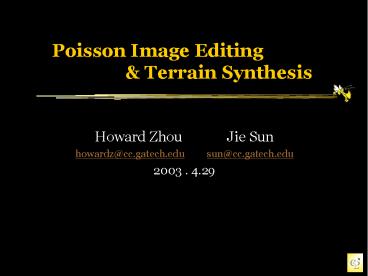Poisson Image Editing - PowerPoint PPT Presentation
Title: Poisson Image Editing
1
Poisson Image Editing Terrain Synthesis
- Howard Zhou Jie Sun
- howardz_at_cc.gatech.edu sun_at_cc.gatech.edu
- 2003 . 4.29
2
Table of Contents
- Introduction / motivation
- Poisson Image Editing
- Terrain Synthesis (Texture based methods)
- Future work
- Conclusion
3
Table of Contents
- Introduction / motivation
- Poisson Image Editing
- Terrain Synthesis (Texture based methods)
- Future work
- Conclusion
4
Introduction / motivation
- Poisson Image Editing
- Seamless
- Texture based terrain synthesis
- Current method based on fractals
- Very limited control
- Terrain style adjusted by parameter tuning
- What if the user draws a rough sketch and supply
a height map and says I want this to be like
this
5
Poisson Image Editing
- Review
6
Our implmentation
- Matlab
- Sparse matrix PDF solver
- Use conjugate gradient solver supplied by Matlab
- Can be faster if
7
Seamless insertion
8
Inserting objects with holes
9
Inserting transparent objects
10
Texture flattening
Result directly related to Edge detection result
11
Local illumination changes
alpha 0.05 beta 0.2
alpha 0.05 beta 0.4
12
Seamless tiling
- Good when seam is not significant
- Often needs to increase the contrast of the
result - but dont an automatic way, maybe use histogram
of the original image
13
Seamless tiling
Good when the seam is not significant
14
Seamless tiling
Show some more
15
Seamless tiling
16
Seamless tiling
17
Seamless tiling
Contrast can be globally fixed But how?
18
Seamless tiling
Seams not good Cannot be fixed
19
Table of Contents
- Introduction / motivation
- Poisson Image Editing
- Terrain Synthesis (Texture based methods)
- Future work
- Conclusion
20
Previous approachTexture based terrain synthesis
- Current method based on fractals
- Very limited control
- Terrain style adjusted by parameter tuning
- What if the user draws a rough sketch and supply
a height map and says I want this to be like
this
21
Texture based terrain synthesis
- Image analogy
- Texture synthesis on laplacian piecewise
seamless tiling - Graph cut / seamless tiling
- Separating the details
22
Data height map
23
Display height map
24
Image analogy
A A' B B'
A. Hertzmann, C. Jacobs, N. Oliver, B. Curless,
D. Salesin.SIGGRAPH 2001
25
Texture by number
26
Texture by number
27
How do we get (A) automatically
- Blurring (filtering)
- Texture flattening using edge detection result or
contour
28
Image analogy (texture flattening blurring)
29
Laplacian Synthesis
- Regard laplacian as a particular texture
- Texture synthesis
- Integrate
30
Results
31
Terrain
32
Terrain
33
Problems possible solutions
- Depend on the boundary conditions
- Use the boundary attached to the Laplacian
- There is only one unique solution of this linear
system - Lost the power of Poisson editing
- Should use a non-conservative gradient field
34
Graph cut seamless tiling
35
Laplacian removing boundary(since the boundary
is known)
36
Image smoothing edge (1 D)
37
Using Poisson Solver
38
Terrain Analysis
- The detail of the terrain differs at different
altitude - Terrain f ( altitude )
- Altitude g ( style )
39
Example Terrain map
40
Low Frequency - Altitude
41
High Frequency as a function of Altitude
42
Proposed Algorithm
- Use Copy Paste methods to generate an
altitude map - Add high frequency probabilistically as indexed
by the altitude map - Graph cuts/Image Quilting to make it seamless
43
Table of Contents
- Introduction (motivation)
- Re-illumination
- Changing viewpoint
- Future work
- Conclusion
44
Future Work
- Other texture methods (Graph cut, stocastic?)
- Stylized map generation from real map
- Real map from stylized map
45
Map vs. terrain
46
Conclusion
- Implemented poisson image editing
- Tried several texture based terrain synthesis
methods - Lots to be done!
47
Questions ?































